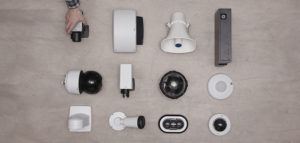Top 5 things to consider when specifying an integrated security and surveillance system
Business owners looking to implement an integrated security and surveillance solution can find the range of options available confusing. The large choice of hardware and software products offer a seemingly endless array of specifications. For instance, a business may benefit from an integrated solution that includes a video management system (VMS) linking various disparate networked products that have been deployed to meet its specific organizational needs. Using a single platform that allows for flexibility when building a security network opens the possibilities for further functionality to be added, such as audio or remote visitor management.
As well as looking at your immediate needs, you need to also consider how your business may change over time. For example, investing in a VMS that integrates different technologies and products may seem unnecessary at the outset, but can make it much easier to manage capabilities and add functionality over time.
Narrowing down the best options for your business can seem overwhelming so, we have outlined some of the key considerations to help identify the security and surveillance solution that best meets your business’ needs.
1. Be clear about your objectives
Why do you want to install a new security and surveillance system? How will it be used within the business? The obvious response to this would be to have ‘better security’, but ‘better security’ means different things to different businesses. The more specific you can be about how you want to use surveillance for your security, the more tailored the solution can be. For example, retailers may need cameras to prevent loss through theft in-store, while an industrial site owner may have more of a focus on protecting their perimeter and their production process.
By looking at how your system will work for your business’ needs, you can determine the key features you require. This will then start pointing to some specific hardware requirements. Make sure that you specify a solution that delivers against all your requirements, while not paying for functionality that you don’t need.
2. Consider your infrastructure and prepare for the data overload
Today’s high-resolution network camera systems create a lot of data. This data needs to be streamed and stored. What implications might this have on your existing infrastructure? Compression technologies such as Zipstream can help significantly reduce streaming and storage requirements, and therefore costs.
3. Know how you’re going to measure ROI
All capital and operational expenditure by a business needs to generate a return, so a security and surveillance solution should be no different. You need to closely look at what that return looks like for your business and how much you are willing to invest based on that. For some businesses this may be more tangible than others: for instance, a retailer can identify a reduction in loss through theft as a clear return, while for other businesses the return is more indirect and harder to quantify. Examples of such indirect return could be decreased insurance costs, increased operational efficiency, or increased customer satisfaction.
4. Make a list of priorities
There will always be budgetary constraints when investing in technology, so it is important to also look at where compromises can be made. If you were buying a car for example (unless you are very lucky!) you have to make sacrifices on non-vital features. For some it makes sense to do without high-spec in-car entertainment if it means a more efficient engine, for others comfort will beat metallic paint and alloy wheels. Once armed with a clear view of your essential features and the budget you have available, you can make an objective choice about what is a ‘must-have’ against a ‘nice-to-have’.
It is also worth looking at where you will be saving money long-term. For example, by investing in an open system where hardware can sit on one software platform, you will be saving money on not having to re-train staff whenever you need to update your system. This makes it easy for your security team to use the solution as part of their existing role.
5. Plan for the future
While a solution may fit your current needs and budget, will it deliver a return over the lifetime of its use, or should you invest in a solution that can grow or adapt as your business needs change? By evaluating these factors, you can make an informed decision on which solution is a justifiable investment.
You may have a specific incentive for installing a new security solution, but only considering what’s needed today rather than what may be needed in the future will not protect your investment long-term.
Does your company have plans to open new sites or offices? Are you growing year-on-year, employing new people? Are you likely to need additional features that your budget can’t support now but will be invested in next year? Your system needs to be agile enough to be able to accommodate these changes in circumstance.
New, unknown security threats can also present themselves. While it is difficult to plan for unforeseen events, a contingency plan is essential for future-proofing your solution. Investigate the options available for a scalable solution that will be able to adapt to your changing business needs, rather than require a new outlay of resources when the time comes to upgrade
More information about End-to-end surveillance solutions.




